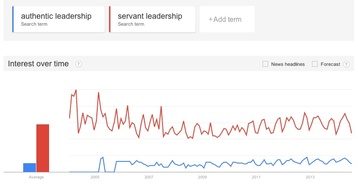
Robert Greenleaf introducing the term “servant leadership” to the leadership lexicon. After retiring from AT&T, he published an essay, The Servant as Leader, in 1970 that was followed by the book, The Servant Leader, in 1976. Servant leaders:
- Are self-aware
- Are empathetic, listen, promote healing and wholeness
- Serve others, committed to stewardship, build community
- Persuasive
- Good foresight and conceptual skills
- Are self-aware, have good self-esteem, are genuine
- Are empathetic, lead with mind and heart, revealing both through actions and emotions
- Service before self; mission and the organization supersede self-interest
- Focus on long term
My take-aways:
1. Neither of these leadership styles is new. They have been around for centuries. What is new is naming, conceptualizing, and researching these approaches. My look at Google trends (see above) shows "servant leadership" is by far the more searched for term. Reasons are speculative. Authentic leadership is the newer term.
2. There does appear to be some overlap in the characteristics above, such as self-awareness and empathy. My guess is the overlap may not be as telling as it appears to be. For example, while important to both, my guess is that self-awareness is more critical to authentic leadership than servant leadership.
3. Both authentic leadership and servant leadership are hard. The authentic leader’s creed must be “be myself.” The authentic leader is authentic, not playing games, not trying to be someone else’s idea of what a leader should be. For the authentic leader, there is no gap between the role of leader and the role of self. This is tough. The authentic leader must have the confidence to be vulnerable.
4. The servant leader may be authentic wholly, in part, or not. For example, one may appear self-aware and empathetic but not be. These perceptions may be cultivated as part of the leader image but not necessarily reflect the inner life of the person. Even in this situation, the servant leader can do great good. My guess, however, is that most leaders who choose this style do so out of a commitment to their fellow human beings.
5. My thoughts here on authentic leadership and servant leadership are just that. My thoughts. Research could clarify. Regardless, I am drawn to the underlying strengths of these approaches.
Rego, A., Sousa, F., Margues, C., & Cunha, M. P. (2014). Hope and positive affect mediating the authentic leadership and creativity relationship. Journal of Business Research, 67, 200-210.
Becker, D. V., & Srinivasan, N. (2014). The vividness of the happy face. Current Directions in Psychological Science, 23 (3), 189-194.
Image of trends for these leadership approaches made using Google Trends™ tool. Google and the Google logo are registered trademarks of Google Inc., used with permission. http://www.google.com/trends/explore#q=authentic%20leadership%2C%20servant%20leadership&cmpt=q
© John Ballard, PhD, 2014. All rights reserved.
 RSS Feed
RSS Feed